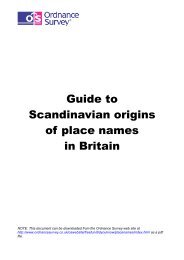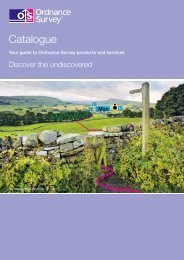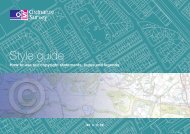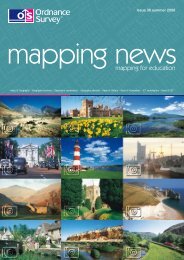235 Kb PDF: Guide to Scandinavian origins of ... - Ordnance Survey
235 Kb PDF: Guide to Scandinavian origins of ... - Ordnance Survey
235 Kb PDF: Guide to Scandinavian origins of ... - Ordnance Survey
You also want an ePaper? Increase the reach of your titles
YUMPU automatically turns print PDFs into web optimized ePapers that Google loves.
<strong>Guide</strong> <strong>to</strong><br />
<strong>Scandinavian</strong> <strong>origins</strong><br />
<strong>of</strong> place names<br />
in Britain<br />
NOTE: This document can be downloaded from the <strong>Ordnance</strong> <strong>Survey</strong> web site at<br />
http://www.ordnancesurvey.co.uk/oswebsite/freefun/didyouknow/placenames/index.html as a pdf<br />
file.
<strong>Guide</strong> <strong>to</strong> <strong>Scandinavian</strong> <strong>origins</strong> <strong>of</strong> place names in Britain<br />
Introduction<br />
Anke-Beate Stahl<br />
Background<br />
<strong>Scandinavian</strong> place names can be found in various places in Scotland. But rather than attributing<br />
them <strong>to</strong> one point <strong>of</strong> origin, we have <strong>to</strong> distinguish between four areas <strong>of</strong> <strong>Scandinavian</strong> influence<br />
and a number <strong>of</strong> people involved in coining those names at different times. Often the <strong>Scandinavian</strong><br />
settlers are referred <strong>to</strong> as ‘Vikings’, but <strong>to</strong> regard them as one coherent group is wrong.<br />
The strongest and longest lasting <strong>Scandinavian</strong> impact on the place names <strong>of</strong> Scotland <strong>to</strong>ok place<br />
in the Northern Isles, that is, Shetland and Orkney. Settlers from Norway arrived around AD800.<br />
The <strong>Scandinavian</strong> overlordship and settlement lasted many centuries and consequently, the vast<br />
majority <strong>of</strong> place names in this area are <strong>of</strong> <strong>Scandinavian</strong> origin.<br />
In the Western Isles, what is referred <strong>to</strong> as Old Norse (ON) was spoken for several centuries, and<br />
many islands, settlements and large geographic features, such as the highest mountains and<br />
largest inlets and bays, still have <strong>Scandinavian</strong> names. The Norse language did not last so long<br />
down the west coast mainland <strong>of</strong> Scotland (from the Clyde northwards), but there <strong>to</strong>o it has left<br />
considerable traces in the place names. The collapse <strong>of</strong> the Norwegian overlordship in 1266 led <strong>to</strong><br />
a resurgence <strong>of</strong> Gaelic and resulted in the widespread gaelicisation <strong>of</strong> place names (that is, the<br />
Gaelic pronunciation and later spelling <strong>of</strong> Norse names), as well as some replacement <strong>of</strong> Norse<br />
names by Gaelic ones. The strength <strong>of</strong> Gaelic varied and increased in the Hebrides <strong>to</strong>wards the<br />
south. Also, many <strong>Scandinavian</strong> words were borrowed in<strong>to</strong> Gaelic as loanwords and were then<br />
used <strong>to</strong> create place names by Gaelic speakers. Examples are Gaelic geodha, ‘gully, chasm’,<br />
which was borrowed from ON gjá, and Gaelic sgarbh, which is derived from ON skarfr, ‘cormorant’<br />
as in Geodha nan Sgarbh (NB0116). Such a place name cannot be called Norse as it was coined<br />
by Gaelic speakers.<br />
The third area <strong>of</strong> <strong>Scandinavian</strong> influence, the south-west <strong>of</strong> Scotland (Dumfries and Galloway), has<br />
close linguistic links not only with the north <strong>of</strong> England but also with the Isle <strong>of</strong> Man and with<br />
Ireland. In this area place names <strong>of</strong> <strong>Scandinavian</strong> origin have been influenced by a number <strong>of</strong><br />
linguistic layers and therefore are not always easily recognisable.<br />
The fourth area, the south-east <strong>of</strong> Scotland, has place name elements that are clearly linked with<br />
<strong>Scandinavian</strong> names <strong>of</strong> the north <strong>of</strong> England. Therefore the place name elements may be traced<br />
back <strong>to</strong> Danish, rather than <strong>to</strong> Norwegian.<br />
As the <strong>Scandinavian</strong> influence on Scottish place names <strong>to</strong>ok place during several unrelated<br />
settlement movements, we are dealing with not just one but several <strong>Scandinavian</strong> languages. The<br />
<strong>Scandinavian</strong> settlers <strong>of</strong> the Northern and the Western Isles spoke West <strong>Scandinavian</strong> or<br />
West Norse, <strong>of</strong>ten referred <strong>to</strong> simply as Norse or Old Norse (ON), from which both Norwegian and<br />
Icelandic are derived.<br />
Whereas the place names <strong>of</strong> the south-west indicate that the <strong>Scandinavian</strong> settlers who arrived<br />
from Ireland, who seem <strong>to</strong> have been mainly West Norse speakers, may already have been<br />
acquainted with Gaelic, the names <strong>of</strong> south-east Scotland point <strong>to</strong> East <strong>Scandinavian</strong> (Danish)<br />
influence. In Shetland and Orkney, Norn, a language that developed from ON, was spoken until the<br />
18th century.<br />
D02454 <strong>Scandinavian</strong>.doc<br />
May 2004<br />
Page 1 <strong>of</strong> 10
<strong>Guide</strong> <strong>to</strong> <strong>Scandinavian</strong> <strong>origins</strong> <strong>of</strong> place names in Britain<br />
Geographic distribution <strong>of</strong> examples<br />
All examples shown in the <strong>Scandinavian</strong> glossary originate from the Northern Isles or north-east<br />
Caithness. This is due <strong>to</strong> the fact that in many <strong>of</strong> the other areas <strong>of</strong> <strong>Scandinavian</strong> influence<br />
subsequent languages have altered the place names, sometimes beyond recognition. In some<br />
parts <strong>of</strong> the country it is very difficult <strong>to</strong> distinguish between Scots and <strong>Scandinavian</strong> place names.<br />
The list <strong>of</strong> <strong>Scandinavian</strong>-influenced place name elements reflects the orthography or spelling on<br />
modern Scottish maps. The entries are arranged in alphabetical order for easy reference. In the<br />
second column each element is linked with its original form, an example being the element brei, as<br />
in the place name Brei Geo (HU3787), which originates from the ON adjective breiðr, ‘broad’. All<br />
ON forms given in the glossary are based on the Icelandic-English Dictionary, whose details are<br />
given in the section below on Further reading.<br />
Alphabet<br />
The column containing the ON forms introduces us <strong>to</strong> a number <strong>of</strong> unfamiliar characters:<br />
• ð: known as ‘eth’, occurs in words such as fjörðr, related <strong>to</strong> Scottish Standard English ‘firth’,<br />
and represents a voiced [th] as in the English definite article ‘the’.<br />
• þ: known as ‘thorn’, represents a voiceless [th], as in English ‘thorn’. It occurs in ON words<br />
such as þing meaning ‘assembly’, ‘meeting place’ and in þveit, ‘piece <strong>of</strong> land’, ‘clearing’.<br />
• ö: found in ON höfn, ‘harbour’, or ON strönd, ‘coast’, ‘shore’ represents a sound very like<br />
German ö (o-Umlaut).<br />
• æ: found in ON words like fær, ‘sheep’ and forms part <strong>of</strong> the names Fair Isle (HZ1871) and<br />
Fara (ND3295).<br />
In addition <strong>to</strong> these characters, another difference between the Norse and the English alphabet is<br />
the Norse use <strong>of</strong> acute accents on the vowels a, o, u, i and y (depicting a sound located between<br />
[u] and [i]). An accent on a vowel means that the vowel is long.<br />
Structure <strong>of</strong> place names<br />
Like place names in most languages, Norse place names are largely descriptive and usually reflect<br />
how the name givers perceived their surroundings. Thus we find names referring <strong>to</strong> the shape <strong>of</strong><br />
natural features, such as Longa Berg (HU3520), ‘long promon<strong>to</strong>ry’, ‘long rock’; or relative location,<br />
such as in Isbister (HU3790) from ON eystri, ‘easterly’; or ON hár, ‘high’, as in Hahouse (HY4551)<br />
or Ha Banks (HY4919).<br />
There is an important group <strong>of</strong> place name elements that refers <strong>to</strong> actual farms or settlements,<br />
such as the frequently found -bie from ON býr, ‘farm’, as in Trenabie (HY4350), South Breckbie<br />
(HY2426) and Houbie (HU4548), ON bólstaðr, ‘farm’, which in Shetland and Orkney occurs as -<br />
bister (Kirkabister (HU5495), Westerbister (HY4602)), but takes the forms <strong>of</strong> -bost, -pol or -bol in<br />
Hebridean place names. The generic -sta is from ON staðir ‘steading’, ‘farm’, as in Hoversta<br />
(HY4117) and Griesta (HU4144), whereas ON setr ‘residence’ and sætr ‘dwelling place’, ‘hill<br />
pastures’, ‘dairy lands’ developed in<strong>to</strong> the frequently occurring element setter, as in Dalsetter<br />
(HU5099) and Winksetter (HY3415), as well as –ster, as in Swinister (HU3380).<br />
Animals such as horses, lambs and sheep are regular components <strong>of</strong> place names and result in<br />
names such as Hestwall (HY4702) from ON hestr, ‘horse’, ‘stallion’, Lama Ness (HY6843), from<br />
ON lamb, ‘lamb’, and Sorquoy (ND4691), from ON sauðr, ‘sheep’. Coastal terminology is <strong>of</strong>ten<br />
inspired by fish and mammals living in the waters such as salmon, ON lax, in Lax Firth (HU4760)<br />
and, whale, ON hvalr, in Whal Geo (HU1751).<br />
D02454 <strong>Scandinavian</strong>.doc<br />
May 2004<br />
Page 2 <strong>of</strong> 10
<strong>Guide</strong> <strong>to</strong> <strong>Scandinavian</strong> <strong>origins</strong> <strong>of</strong> place names in Britain<br />
Soil type inspired names such as Grut Ness (HU6592) from ON grjót, ‘gravel’, and Lerwick<br />
(HU4841) from ON leir, ‘mud’, ‘clay’. An important category <strong>of</strong> descriptive place names are, <strong>of</strong><br />
course, colours with ON svartr, ‘black’, as in Swarthoull (HU2978), ON rauðr, ‘red’, in Roe Clett<br />
(HU3978) and ON grár, ‘grey’, as in Grobust (HY4249), <strong>to</strong> name but a few.<br />
The <strong>Scandinavian</strong> place names <strong>of</strong> Scotland follow straightforward composition patterns. Most<br />
place names are made up <strong>of</strong> more than one element, with a linguistic relationship between the<br />
elements. The element qualifying a generic element is called a qualifying or specific element.<br />
• Definite article + generic: Place names can consist <strong>of</strong> a single generic element, usually a noun.<br />
These are <strong>of</strong>ten preceded by the English definite article ‘the’. Examples are, The Tongues<br />
(HU3721) from ON tangi, ‘spit <strong>of</strong> land’, ‘<strong>to</strong>ngue’, The Skeo (HU4434) derived from ON skjá, ‘hut<br />
for drying fish’, and The Crook (HU2986), based on ON krókr, ‘bend’.<br />
• Specific + generic: This is the most frequent composition pattern. Whereas generics are always<br />
nouns, specifics can be either nouns or adjectives. Typical examples <strong>of</strong> names consisting <strong>of</strong> an<br />
adjective and a noun are Deepdale (HU3825), ‘deep valley’, from ON djúpr, ‘deep’, and ON<br />
dalr, ‘valley’, and Brettabister (HU4857), from ON brattr, ‘steep’ and ON bólstaðr, ‘farm’.<br />
Breiwick (HU2256), from ON breiðr, ‘broad’ and vík, ‘bay’ follows the same pattern, as does<br />
Midness (HU4572), from ON miðr, ‘middle’ and ON nes, ‘headland’, ‘promon<strong>to</strong>ry’.<br />
• Generic + preposition + existing place name: Place names following the above pattern are very<br />
typical <strong>of</strong> the Northern Isles. The preposition linking the generic and the specific is usually the<br />
Scottish English word <strong>of</strong> (Scots o). The specific is always an existing place name. Examples <strong>of</strong><br />
this pattern are Burn <strong>of</strong> Forse (HU5289), Garth <strong>of</strong> Tresta (HU6190), Burn <strong>of</strong> Swartabeck<br />
(HY3808) and Clett <strong>of</strong> Thusater (ND0671).<br />
<strong>Scandinavian</strong> place names <strong>of</strong> Orkney and Shetland have been subject <strong>to</strong> extensive research. In<br />
Shetland a pilot project has been set up <strong>to</strong> collect and record local place names from lists <strong>of</strong><br />
names, maps, documents held locally and – most importantly – local informants. The place names<br />
are entered in a database intended <strong>to</strong> promote and ease cross-disciplinary research. The Shetland<br />
Place-Names Project involves local his<strong>to</strong>ry groups, day-care residents and individuals from<br />
throughout the islands. The project is currently funded until the end <strong>of</strong> March 2005.<br />
Further reading<br />
Cleasby, Richard; Vigfusson, Gudbrand (1957): An Icelandic-English Dictionary, 2nd edition,<br />
Oxford University Press. For an online version <strong>of</strong> the first edition (1874) see<br />
http://www.northvegr.org/vigfusson/<br />
Jakobsen, Jakob (1936): The Place-Names <strong>of</strong> Shetland, London and Copenhagen.<br />
Marwick, Hugh (1952): Orkney Farm Names, Kirkwall.<br />
Nicolaisen, W F H (2001): Scottish Place-Names – Their Study and Significance, John Donald,<br />
Edinburgh.<br />
Stewart, J. (1987): Shetland Place-Names.<br />
For further information on the Shetland Place-Names Project contact:<br />
Eileen Brooke-Freeman, Project Officer, Place Names<br />
Shetland Amenity Trust<br />
Garthspool, LERWICK, Shetland, ZE1 0NY<br />
Phone: 01595 694688<br />
Fax: 01595 693956<br />
Email: eileen@shetlandamenity.org<br />
www.shetland-heritage.co.uk<br />
Useful links:<br />
D02454 <strong>Scandinavian</strong>.doc<br />
May 2004<br />
Page 3 <strong>of</strong> 10
<strong>Guide</strong> <strong>to</strong> <strong>Scandinavian</strong> <strong>origins</strong> <strong>of</strong> place names in Britain<br />
Scottish Place-Name Society<br />
http://www.st-andrews.ac.uk/institutes/sassi/spns/<br />
D02454 <strong>Scandinavian</strong>.doc<br />
May 2004<br />
Page 4 <strong>of</strong> 10
<strong>Guide</strong> <strong>to</strong> <strong>Scandinavian</strong> <strong>origins</strong> <strong>of</strong> place names in Britain<br />
Glossary<br />
Place names are made up <strong>of</strong> components which are referred <strong>to</strong> as elements. These elements are simply the words people used <strong>to</strong> describe a place or<br />
their response <strong>to</strong> their environment. A more complete background <strong>to</strong> <strong>Scandinavian</strong> in place names, pronunciation and spelling can be found in the<br />
preceding Introduction.<br />
This is a glossary <strong>of</strong> the elements from <strong>Scandinavian</strong> most frequently found in the place names <strong>of</strong> Britain. The first column gives the name element in the<br />
form found in place names. The original Old Norse word from which the element derives follows, <strong>to</strong>gether with its meaning. Examples (with grid<br />
references) are given for each element.<br />
Abbreviations:<br />
adj = adjective<br />
nf = noun feminine<br />
nm = noun masculine<br />
nn = noun neuter<br />
ON original<br />
Element<br />
Meaning Examples<br />
element<br />
a ey nf island Foula HT9539, Fladda HU3784<br />
ay ey nf island Orfasay HU4977, Housay HU6771<br />
ayre eyrr nf gravelly bank Ayre <strong>of</strong> Breiwick HU5561, Fugla Ayre HU4661<br />
baa boði nm hidden submerged rock, breaker, reef Flugga Baa HU6299, Gerda Baa HU5799<br />
back, bakka bakki nm bank <strong>of</strong> a river, slope Backarass HY4148, Ness <strong>of</strong> Bakka HU1751<br />
beck bekkr nm brook, burn Knowes <strong>of</strong> Maebeck HY4952, Burn <strong>of</strong> Swartabeck HY3808<br />
berg berg nn promon<strong>to</strong>ry, rock, rocky soil Longa Berg HU3520, Midberg HU5988<br />
bie bœr, býr nm farm Murbie Stacks HU3062, Houbie HU6190<br />
bister bólstaðr nm dwelling place, house Kirkabister HU5495, Westerbister HY4602<br />
bratta brattr adj steep Bratta Stack HU5989, Brattibeck HU2844<br />
breck brekka nf slope Brattabreck HU3892, Breck <strong>of</strong> Hillwell HU3714<br />
D02454 <strong>Scandinavian</strong>.doc<br />
May 2004<br />
Page 5 <strong>of</strong> 10
<strong>Guide</strong> <strong>to</strong> <strong>Scandinavian</strong> <strong>origins</strong> <strong>of</strong> place names in Britain<br />
Element<br />
ON original<br />
element<br />
Meaning Examples<br />
brei breiðr adj wide, broad Brei Geo HU3787, Breiwick HU2256<br />
bretta brattr adj steep Brettabister HU4857, Brettavale HY3020<br />
brim brim nn surf Brim Ness HP5105<br />
burra borg nf fortification West Burra HU3632, Noust <strong>of</strong> Burraland HU3775<br />
by bœr, býr nm farm Houseby HY6721, Tip<strong>to</strong>by HU6091<br />
clett klettr nm rock Clett Skerry ND3095, Clett <strong>of</strong> Thusater ND0671<br />
cliff kleif nf rock Cliffdale HY6325, Moo Cliff HY3906<br />
crook krókr nm bend The Crook HU2986, Crooksetter HU4076<br />
cros, cross kross nm cross, junction Crosbister HP5803, Cross Kirk HU2178<br />
dale dalr nm valley Deepdale HU3825, Quendale HU3714<br />
deep djúpr adj deep Deepdale HU3825<br />
fair, far fær nf sheep Fair Isle HZ1871, Fara ND3295<br />
fell fjall nn rough hill, mountain Kat Fell HU3268<br />
firth fjörðr nm firth, fjord, sea-loch Sellafirth HU5198, Laxfirth HU4759<br />
fiska, fiski fiskr nm fish North Fiski Geo HU4696, Fiska Ness HU3066<br />
fladda flatr adj flat Fladdabister HU4332, Fladda HU3797<br />
fors, forse fors nm waterfall Forse HY5300, Burn <strong>of</strong> Forse HU5289<br />
foul fugl nm fowl, bird Foula HT9539, Foulageo HU4335, Foula Wick HU3664<br />
garth garðr nm enclosure, fence, farmyard Frustigarth HY5218, Garths <strong>of</strong> Tresta HU6190<br />
geo gjá (gjó) nf chasm, rift, gully Ramnageo HP6200, Sultigeo HY3011<br />
gerdi gerði nn enclosure Gerdie HP6208<br />
gil, gill gil nn ravine, narrow gully Djupa Gill HU4066, Feetnies Gill HU3615<br />
D02454 <strong>Scandinavian</strong>.doc<br />
May 2004<br />
Page 6 <strong>of</strong> 10
<strong>Guide</strong> <strong>to</strong> <strong>Scandinavian</strong> <strong>origins</strong> <strong>of</strong> place names in Britain<br />
Element<br />
ON original<br />
element<br />
Meaning Examples<br />
gro grár adj grey Grobister HY6524, Grobust HY4249<br />
gruin, grunna grunn nn shallows Grunna Voe HU4766<br />
grut grjót nn gravel Grut Ness HU6592, Grut Wick HU5070<br />
ha, haa hár adj high, upper Ha Banks HY4919, Hahouse HY4551<br />
ham höfn nf haven, harbour Hamister HU5463<br />
hamar hamarr nm steep rock, rocky hillside Hamar HU5894, Hamar Geo HU5191<br />
hamma, hammer hamarr nm steep rock, rocky hillside Hamma Cletts HU3166, Hamma Ayre HU3361<br />
hamna höfn nn haven, harbour<br />
Hamna Heog HP6509, Hamna Dale HU5065, Hamnavoe<br />
HU4980<br />
heog haugr nm mound, cairn Heog HU4971, Heoga Berg HU4538<br />
hesta, hesti hestr nm horse, stallion Hesti Geo HU3881, Hestwall HY4702<br />
hevda höfði nm headland S<strong>to</strong>ur Hevda HU5273, Hevdawick HU3365<br />
ho hár adj high, upper Hoy HU3744, Hoo Field HU4227<br />
hoga hagi nm outfield, pasture Hogaland HU3936, Hoga Ness HP5500<br />
holm holmr nm islet Holm <strong>of</strong> Burrafirth HU3557, Long Holm HY3014<br />
hope hópr nm bay Longhope ND3292<br />
houll hóll nm hill Moss Houll HU5181, Queys Houll HU6098<br />
housa hús nn house Housabister HU4958, Housa Wick HU5491<br />
howe haugr nm mound, cairn Howe Taing ND4294, Maes Howe HY3112<br />
hus hús nn house The Hus HU1655<br />
is eystri adj easterly Isbister HU3790<br />
kirk kirkja nf church Kirk Ness HU5565, Kirkabister HU5495<br />
D02454 <strong>Scandinavian</strong>.doc<br />
May 2004<br />
Page 7 <strong>of</strong> 10
<strong>Guide</strong> <strong>to</strong> <strong>Scandinavian</strong> <strong>origins</strong> <strong>of</strong> place names in Britain<br />
Element<br />
ON original<br />
element<br />
Meaning Examples<br />
lama lamb nn lamb Lama Ness HY6843<br />
land land nn piece <strong>of</strong> ground Houlland HU5080, Mailand HP6008<br />
lang langr adj long Langa Skeo HY3208<br />
lax lax nm salmon Lax Firth HU4760<br />
lee hlið nf hillside, slope Lee <strong>of</strong> Laxo HU4563, Lee Taing HU4333<br />
ler leir nm mud, clay Lerwick HU4841, Ler Geo HU2585<br />
ling lyng nn heather Lingarth HP6009<br />
lund, lunn lundr nm grove Lunnasting HU4665, Lunna Ness HU5071<br />
mid miðr adj middle Midbister ND4490, Midness HU4572<br />
mire mýrr nf swampy moorland, mire Hesta Mires HU4994, Mires <strong>of</strong> Oddsetter HU5992<br />
ne nyr adj new Nebister HY6337<br />
neap gnípa nf, gnúpr nm steep hill Hamara Neap HU5966, West Neap HU5891<br />
ness nes nn headland, promon<strong>to</strong>ry Ness HU2158, Scat Ness HU3809<br />
nor norðr adj northerly Norbister HU3732, Norwick HU3681<br />
noup gnúpr nm peak Noup Head HY3950, Noup <strong>of</strong> Noss HU5539<br />
pap papi nm priest, cleric Papa Skerry HU3738, Papa S<strong>to</strong>ur HU1660<br />
pund pund nn enclosure Pund <strong>of</strong> Burravoe HU3890, Houlls Pund HP5805<br />
qui kví nf enclosure Qui Ayre HY2115, Qui Ness HP6203<br />
quoy kví nf enclosure Quoys <strong>of</strong> Catfirth HU4454, Gritquoy HP5803<br />
ramna hrafn nm raven Ramna Geo HU5591, Ramna Taing HU3242<br />
roe rauðr adj red Roe Clett HU3978, Roeness HU3243<br />
ron, rona, roo, roonies hraun nn rocky hill-ground Langa Roonies HU3367, Roonie Geo ND3792<br />
D02454 <strong>Scandinavian</strong>.doc<br />
May 2004<br />
Page 8 <strong>of</strong> 10
<strong>Guide</strong> <strong>to</strong> <strong>Scandinavian</strong> <strong>origins</strong> <strong>of</strong> place names in Britain<br />
Element<br />
ON original<br />
element<br />
Meaning Examples<br />
ros, ross (h)ross nn horse Ross Geo HY4849<br />
scord skarð nn valley crossing a ridge Scord HU5992, Northscord HU3366<br />
setter setr, sætr nn dwelling place, house Dalsetter HU5099, Winksetter HY3415<br />
sil sild nf herring Silwick HU2942<br />
ska skagi nm cape, low point <strong>of</strong> land Skaaga HU1655, Skaw HP6516<br />
skaill skáli nm hut, shieling Langskaill HY4321, Aikerskaill HY5804<br />
skeo skjá nf hut for drying fish or meat Langa Skeo HY3208, The Skeo HU4434<br />
sker sker nn skerry Taing <strong>of</strong> Tor Sker HY7345, Innsker HY5221<br />
so sauðr nm sheep Sorquoy ND4691<br />
sta staðir (pl) nm steading farm Hoversta HY4117, Griesta HU4144<br />
stack, stakk stakkr nm hill, precipi<strong>to</strong>us rock Aastack HU4596, Stakka Vatn HU3529<br />
stane steinn nm (standing-)s<strong>to</strong>ne Whitestanes HY4715, Kirk Stane HY5316<br />
stav stafr nm staff, post, stick, stave Stav Geo HU3786, Stava Ness HU5060<br />
stem, sten steinn nm (standing-)s<strong>to</strong>ne Stenness HU2177, Stembister HY5302<br />
ster setr, sætr nn dwelling place, house Swinister HU3380, Ocklester HY5102<br />
s<strong>to</strong>ur stórr adj big Papa S<strong>to</strong>ur HU1660, S<strong>to</strong>ur Houll HU3073<br />
strand strönd nf coast, shore Strand HU6691<br />
strom straumr nm stream, running water Strom HU3948, Stromfirth HU4050<br />
swart svartr adj black, dark Swarthoull HU2978, Swart Hamar HY6238<br />
sweinn, swin svín nn pig Sweinna Stack HU4391, Swinister HU3380<br />
taft <strong>to</strong>pt, tupt nf house, site, foundation Evertaft HY4551, Kirkatafts HU5598<br />
taing tangi nm <strong>to</strong>ngue, spit <strong>of</strong> land Taing <strong>of</strong> Berstane HY4710<br />
D02454 <strong>Scandinavian</strong>.doc<br />
May 2004<br />
Page 9 <strong>of</strong> 10
<strong>Guide</strong> <strong>to</strong> <strong>Scandinavian</strong> <strong>origins</strong> <strong>of</strong> place names in Britain<br />
Element<br />
ON original<br />
element<br />
Meaning Examples<br />
ting þing nm assembly, meeting place <strong>of</strong> parliament Tingwall HY4022, North Nesting HU4559<br />
<strong>to</strong>ft <strong>to</strong>pt, tupt nf house, site, foundation T<strong>of</strong>ts <strong>of</strong> Tain ND2465, Thurdis<strong>to</strong>ft ND2067<br />
<strong>to</strong>ngue tunga nf <strong>to</strong>ngue, spit <strong>of</strong> land The Tongues HU3721, Tongue Field HU4131<br />
twatt þveit nf piece <strong>of</strong> land, clearing Stennestwatt HU<strong>235</strong>1, Brunatwatt HU2450<br />
vat, vatn vatn nn lake Vatsland HU4646, Virda Vatn HU3529<br />
vird, virda varða nf heap <strong>of</strong> s<strong>to</strong>nes, cairn Vats Virda HU4333, Middis Vird HU3072<br />
voe vágr nm small sheltered bay Loura Voe HU4453, Snarravoe HP5602<br />
wall, well völlr nm field, level ground, meadow Tingwall HY4022<br />
west vestr adj westerly Holm <strong>of</strong> Westquoy HY3607<br />
whal, whale hvalr nm whale Whale Firth HU4693, Whal Geo HU1751<br />
wick vík nf bay Whale Wick HU3632, Wick <strong>of</strong> Aith HU6389<br />
D02454 <strong>Scandinavian</strong>.doc<br />
May 2004<br />
Page 10 <strong>of</strong> 10







